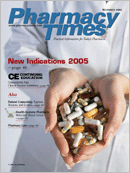Pharmacy Compounding Is Flourishing Once Again
In the early days of pharmacy, compounding medications was an integral part of a pharmacist's daily duties. Medications were prepared in the pharmacy from stock bottles of ingredients that lined the shelves. During the 1930s and 1940s, about 60% of prescriptions were compounded by pharmacists.1
The role of the pharmacist has changed over the years due to advances in the field of pharmacy and the emergence of new drug-manufacturing technology. In many ways, the role of the pharmacist progressed from being the "medication preparer" to being the "dispenser of manufactured medications," and this change greatly decreased the need for pharmacy compounding. As the profession of pharmacy evolved over the years, so did the role of the pharmacist in addressing and meeting the needs of patients.
Today, however, compounding pharmacies have begun to flourish and are once again becoming a vital component of pharmacy practice. Many health care professionals recognize that, for some specific patient populations, there is a growing need to compound certain medications because they are not available through conventional manufacturing methods. Studies suggest that compounding produces 1% of all prescriptions filled each year. In 2003, it was estimated that 30 million prescriptions were compounded products.1 Many compounding pharmacies have established Web sites that promote their compounding services. Many compounding pharmacies specialize in compounding customized medications in various dosage forms that can be tailored to meet a patient's individual need.
The FDA defines traditional pharmacy compounding as "the combining, mixing, or altering of ingredients to create a customized medication for an individual patient in response to a licensed practitioner's prescription."1 Compounding, in its simplest form, can involve making a new formulation of an approved medicine, such as adding a flavoring agent to make it more palatable. This practice is particularly useful for the pediatric population for enhancing patient compliance. Compounding also may involve a more complex approach, such as making an entirely different dosage form of a medication to suit the specific needs of a patient. For example, compounding may involve making a suspension or solution for a patient who has difficulty swallowing oral solids, or compounding a medication that is preservative-or dye-free (Table 1).
Reasons for Compounding
One of the most important reasons why it may be necessary to use a compounded medication is patient intolerance of a manufactured product. This intolerance, in turn, leads to an increase in patient noncompliance.1 When necessary, compounding allows physicians to prescribe customized dosage systems for individuals who cannot tolerate the standard manufactured preparation of a particular pharmacologic agent. Therefore, a physician can write a customized prescription for a patient, and, if possible, the pharmacist can prepare the medication in a variety of dosage systems, such as transdermal gels, sublingual dosage forms, medicated lollipops, preservative-free preparations, suppositories, or liquid suspensions. Table 2 shows the different areas of medicine that may require the services of compounding pharmacies.
Regulation of Compounding Pharmacies
In 1997, national pharmacy organizations joined their efforts to ensure that pharmacists could continue to meet the needs of patients through compounding and to create standards for the practice of compounding. The National Association of Boards of Pharmacy (NABP) formulated "Good Compounding Practices" that have been used in many states. The US Pharmacopoeia (USP) Convention prepared monographs USP <795> and <797>, informed by the work of the NABP, establishing standards for extemporaneous compounding of nonsterile and sterile preparations. The particular location of these monographs in the USP/National Formulary (NF; that is, numbered below <1000>) means that they are enforceable standards for the FDA.2
The FDA, as a regulatory body, promulgates standards where none exist. Here, an act of Congress mandates that the FDA adhere to the standards of the USP/NF when examining or proposing to examine pharmacies. Furthermore, the FDA leaves the regulation of pharmacy practice to the individual states but has memoranda of agreement with the various states to allow exchange of information between it and the state boards of pharmacy for enforcement and compliance purposes.
The FDA, in addition, provides Compliance Policy Guidelines (CPGs), one of which applies to pharmacy. The CPG on Pharmacy Compounding outlines the areas in which a pharmacy might be found to be in violation of standards and therefore found to be, for example, a pharmaceutical manufacturer, and therefore subject to federal regulation.
Some examples include when a pharmacy compounds large quantities of a drug for sale, rather than for filling individual patient prescription(s), and advertises price, quantity, and particular formulation.3 Other examples can be found in the CPG at http://www.fda.gov/ora/compliance_ref/cpg/cpgdrg/cpg460-200.html.
Role of the Pharmacist in Compounding
Whereas the services provided by compounding pharmacies give many patients options with regard to drug therapy, compounding pharmacists must be properly trained to specialize in this aspect of pharmacy practice and must have the appropriate resources and references to compound quality medications. Pharmacists are responsible for ensuring that extemporaneous preparations are compounded according to compounding guidelines and standards with respect to purity, quality, stability, packing, record keeping, and other appropriate pharmacy practices. Compounding pharmacists must work closely with the prescribing physician to ensure that patient goals are met. A positive therapeutic outcome for the patient is the fundamental goal for all health care professionals, and, with that goal in mind, the services provided by compounding pharmacies can continue to make pharmacists an indispensable part of the health care team.
For more information on pharmacy compounding, visit the following Web sites:
- FDA, www.fda.gov
- International Academy of Compounding Pharmacists, www.iacprx. org/index.html
- Gallipot Professional Services, www.gallipot.com
- Secundum Artem, available at Paddock Laboratories Web site, www.paddocklabs.com
- Professional Compounding Centers of America, www.pccarx.com
- National Association of Boards of Pharmacy, www.nabp.com
Ms. Terrie is a clinical pharmacy writer based in the northern Virginia area.
For a list of references, send a stamped, self-addressed envelope to: References Department, Attn. A. Stahl, Pharmacy Times, 241 Forsgate Drive, Jamesburg, NJ 08831; or send an e-mail request to: astahl@ascendmedia.com.

